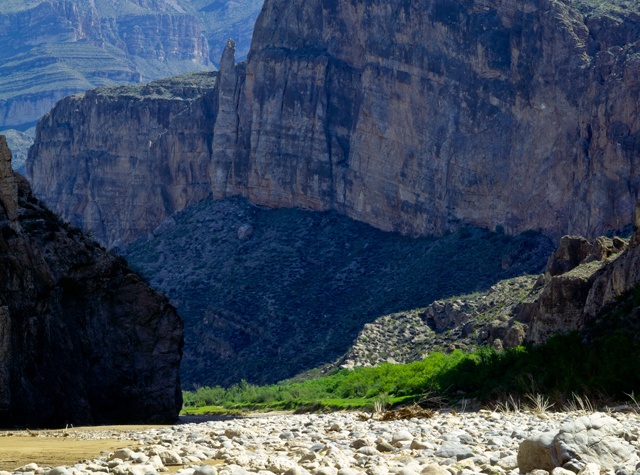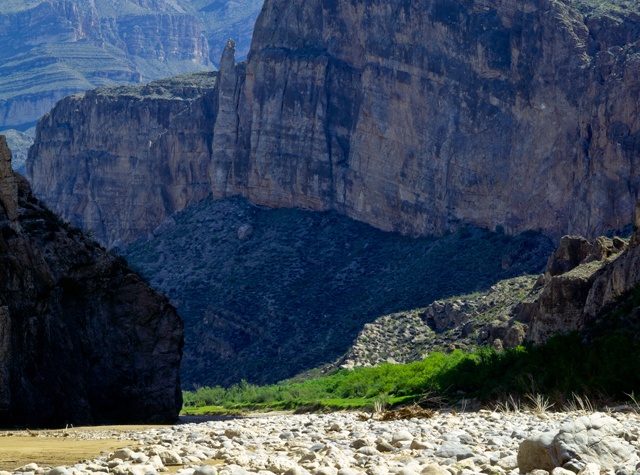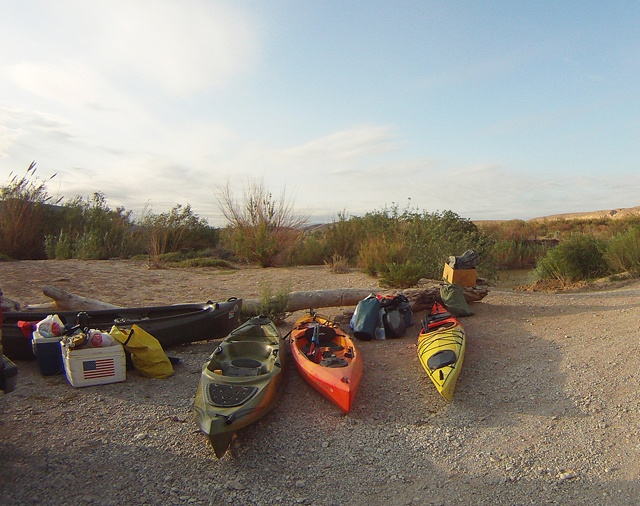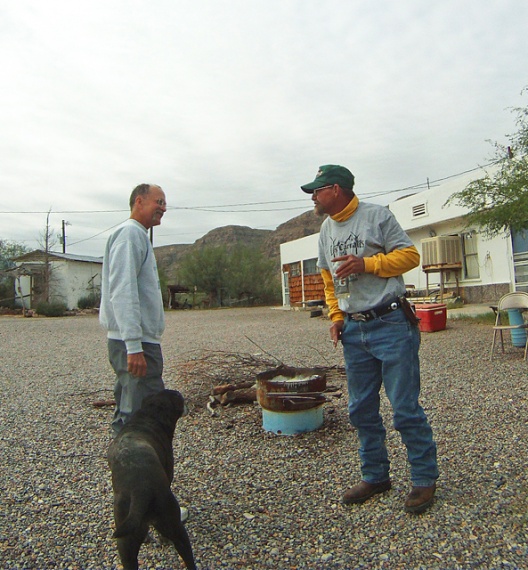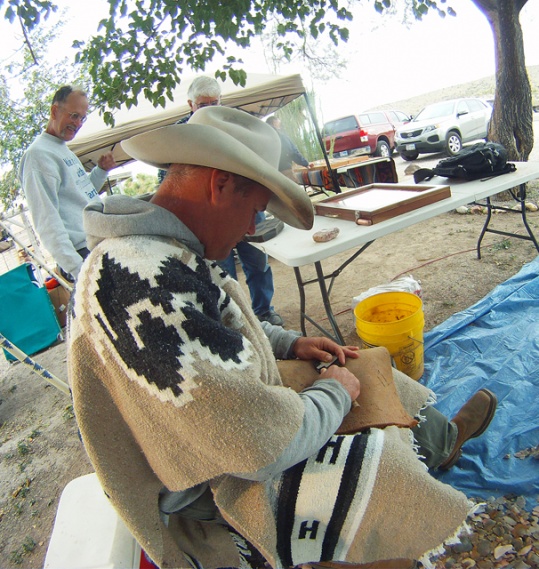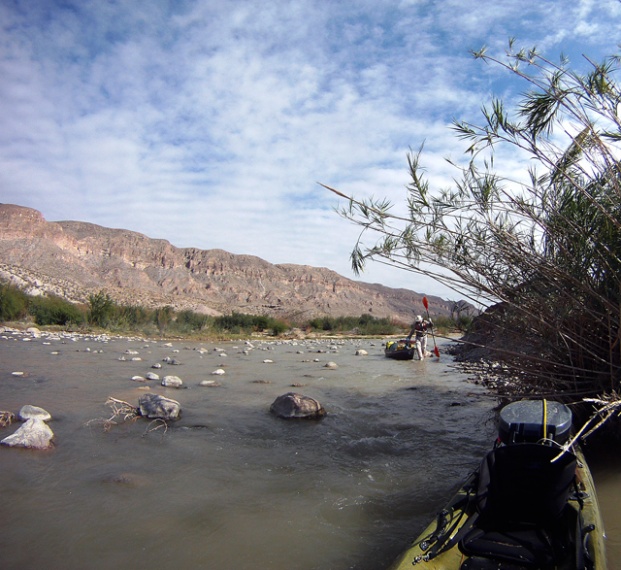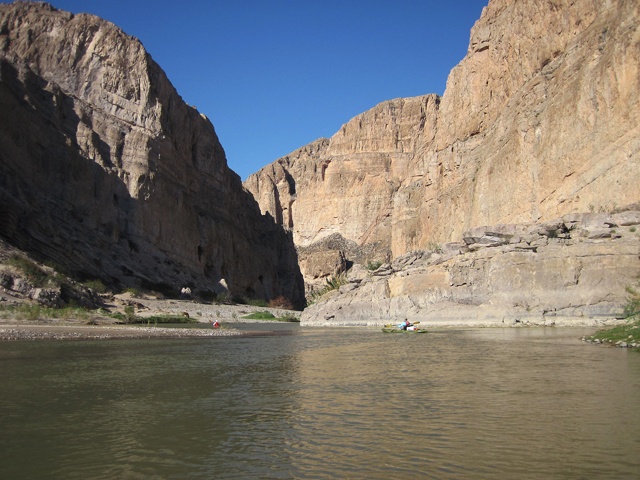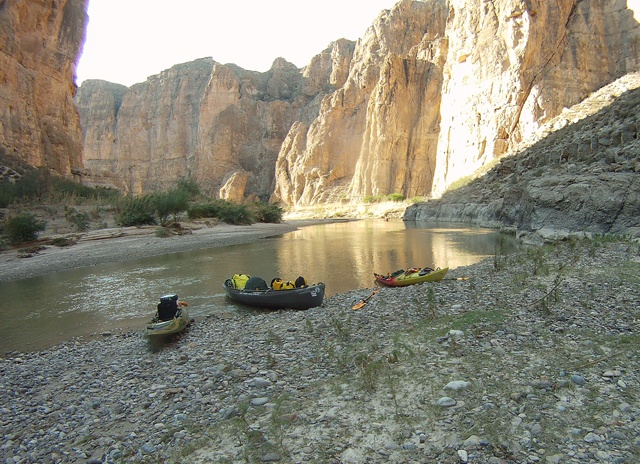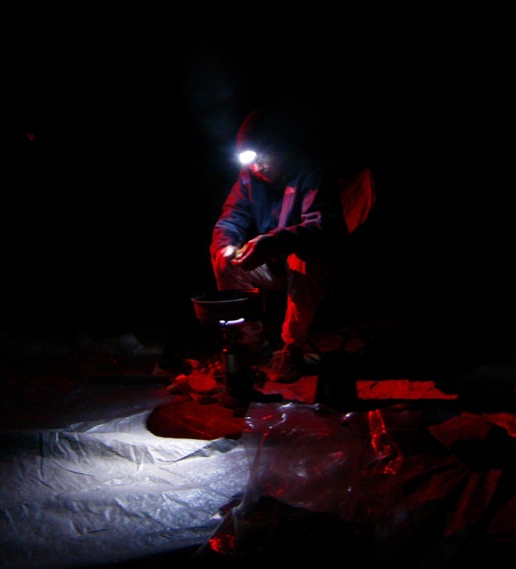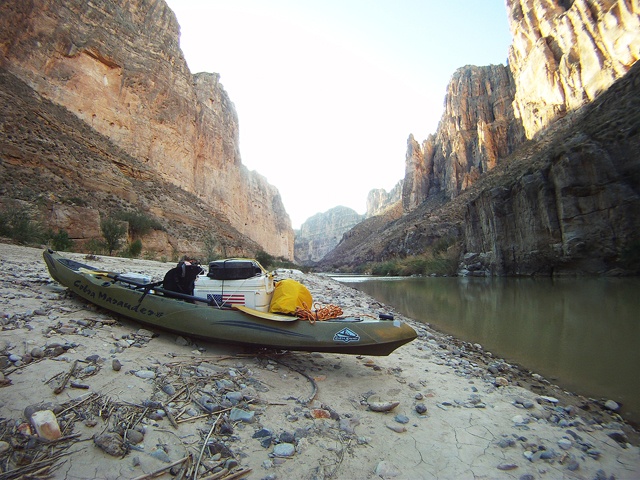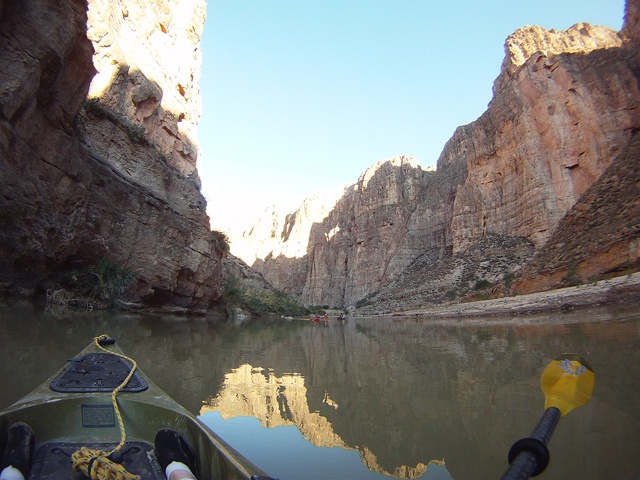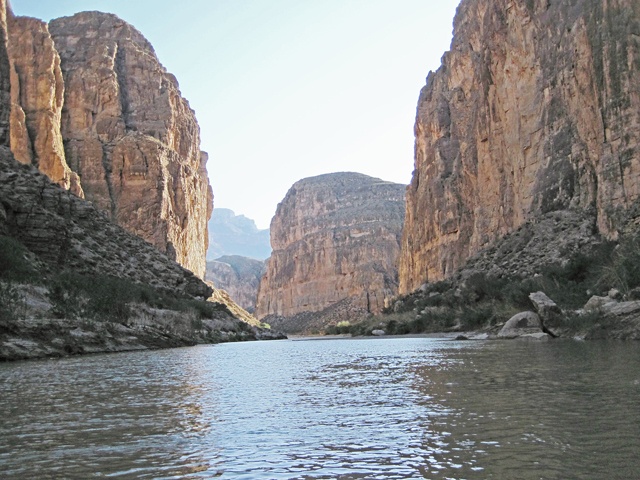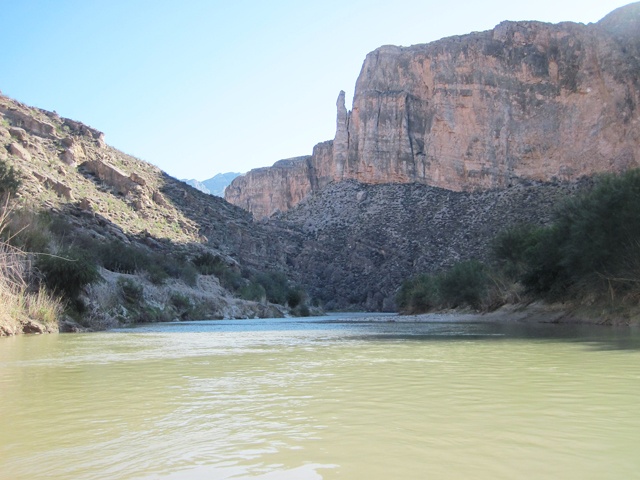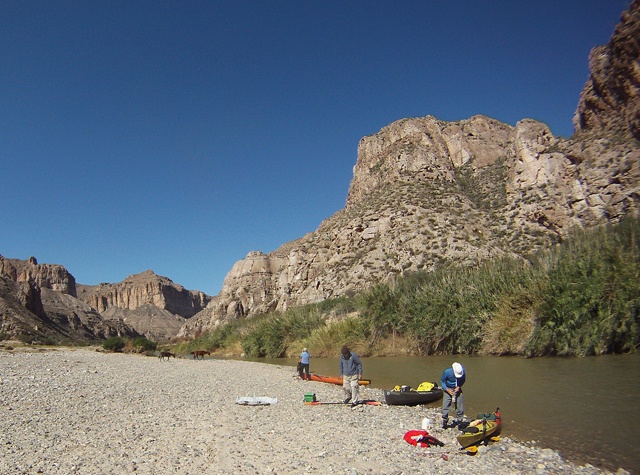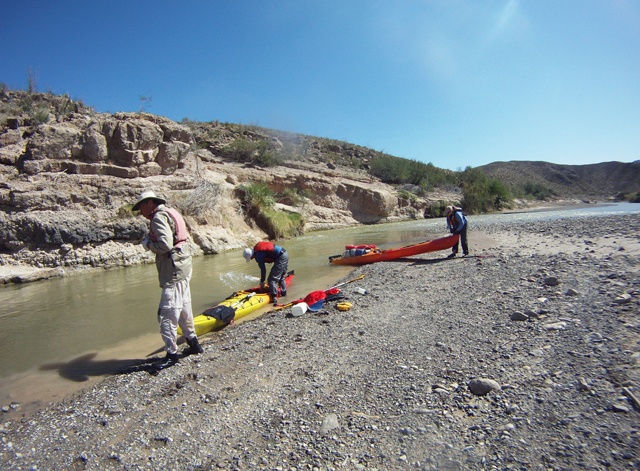When Herb Nordmeyer goes on vacation, he packs light, depends only on satellite, and then slides off the map. It’s early autumn, and this 71-year-old kayaking guide is embarking on a three-day paddling trip through Boquillas Canyon on the Rio Grande, the wild and scenic river that forms the slippery boundary between Texas and Mexico. For his 33-mile journey, Nordmeyer has invited two close friends—experienced kayakers Curt Pearson and Christie Smith. And me.
The night before our launch, Nordmeyer, Pearson, Smith and I watch the embers die on a grill at Rio Grande Village Campground, and we tell ghost stories. Pearson begins, recounting a scene from his time as a military hospital administrator in Korea. I tell of getting lost in the Nevada mountains between the Singatse Range and Pine Grove Hills. Nordmeyer relives a night in Vietnam. Smith, a retired army nurse, says she has a story but needs to sleep on it, cuing us all to our sleeping bags to ward off the rising wind and haunts of the past.
Day 1
The next day, it’s nearly 2 p.m. when we hit the water after shuttling our vehicles to the takeout point at Heath Canyon Ranch near La Linda, Mexico, the only convenient way off the river between the Upper and Lower canyons of the Rio Grande.
“I’ve got the river,” says ranch caretaker Fred Keller, a retired career Marine who sought solace in the desert 10 years ago and never left. He explains the next takeout spot beyond the ranch is 84 miles—five days—downstream. Smoking a hand-rolled cigarette under the brim of his Harley-Davidson cap, Keller sees us off at the cinderblock-and-mud boat ramp and offers a parting word of advice: “Now,” he warns, “don’t pick up the firewood that wiggles.”
I, in a 14-foot Cobra Marauder kayak, am first in and promptly get high-centered on a rock. The water is flowing a low 75 cubic feet per second, which carves an unpredictable course of narrow rapids, slow-moving pools and sandbars through the Chihuahuan Desert, and I’ve found the first obstacle on this route.
Using my paddle like a pole, I push off the river bottom and get unstuck just in time to rush widdershins into the first rapid. The current drives me straight into a clump of giant reeds, an invasive plant that grows about 20-feet-high on the banks and curves over the water like coarse woven traps. I slide under the first thicket, nearly get dunked by the second and finally emerge on the other side. I right my hat and sunglasses, toss the debris off the boat and catch up with the crew, realizing we’re being watched. Across the river, a man observes us from a bareback horse on the shore of Mexico, just a few feet away.
Fifteen minutes down. Three days to go.
For most of the next 2 1/2 hours, we row under a cloudy sky into the wind—and into whitecaps—while we follow the weaving Rio Grande. With Texas on our left, Mexico on our right, we alternately walk sandbars and run gentle rapids under the wary gaze of stray horses, wild donkeys and goats. At the village of Boquillas del Carmen, Mexico, residents dot the bluff above to watch us paddle by.
About five miles in, what had looked like a mere mountain from a distance now splits for the Rio Grande—the entrance to Boquillas Canyon.
“Yesterday I took you to the far blue mountains,” Nordmeyer says of our arrival at Big Bend National Park’s misty Chisos Mountains. “Today, let me introduce you to my friend Boquillas.”
Here, centuries of strata and sediment of the Sierra del Caballo Muerto, a subrange of the desert’s sweeping Sierra del Carmen, roll into the river on the Texas side. On the other, a limestone cliff with a teardrop-shaped cave rises from the water in Mexico. The wind intensifies at the entrance as it would through a funnel, and the sun peeks out of the clouds.
“Scenes like this,” Pearson says, marveling. “God knew what he was doing when he created this stuff.”
We’re not alone. I spy two hikers looking down from Boquillas Canyon Overlook, and on a sandbar on our level, a Mexican woman, wearing a black floral dress that billows in the wind, and two men behold the entrance to the canyon. Three horses roam nearby; two are bareback and one wears a clanging cowbell.
Just after 5 p.m., we pull ashore to camp at about the seventh mile on a sandbar of cracked mud on the Texas side. The wind rises still more as we change into dry clothes, warm our toes and secure tents with stakes and smooth, heavy river rocks. We’re just getting comfortable when we get a visitor.
“Doggone, here comes a horse,” says Pearson, who’s ready to shoo the unexpected guest from our campsite. We’d passed up a site a mile earlier because several horses roamed that shore.
“Guess who’s coming to dinner,” Smith teases, but the lone brown horse walks on, uninterested in the beef and noodle soup she’s trying to warm over Nordmeyer’s propane camp stove, a feat made difficult as the wind carries away most of the heat from the flame.
We turn in soon after dark, the cold wind howling through the canyon with gusts that flatten our tents against our heads as we sleep.
Day 2
Next morning before launch at about 9:30, Nordmeyer asks if I’d been cold yesterday. “Because I have a tablecloth,” he expertly announces like I should know how that will help. Resisting the urge to laugh, I wait for him to explain that I should drape the blue plaid and floral vinyl over my lap to stay dry.
It’s tacky and smells like onion, but it keeps me warm, and I happily wear it all day—except for a short reprieve when I spread it on a pebbled beach at lunchtime. Munching on salami, gouda cheese, tortillas, tangerines and spoonsful of Pearson’s military ready-to-eat meal, Smith regales us with a tale of crab hunting at night among alligators in Louisiana—at last, her harrowing story.
As the sun highlights the rim of the canyon—with some walls towering a quarter-mile up—we find our rhythm in the shadows below. Sometimes paddling in a tight formation and other times drifting far apart from leader to last, we take in the desert around us—miniature whirlwinds of small lemon-yellow butterflies, mud nests of swallows on limestone overhangs, tree tobacco, salt cedar, prickly pear and Lizard Rock, a towering pillar of limestone that looks like a reptile slithering up the face of a cliff in Mexico.
Nordmeyer sways side to side in his gray Mad River Canoe, which holds our excess gear, taking frequent breaks to consult GPS and waterproof maps through square eyeglasses. Smith, riding a red Necky kayak, dips her paddle into the water without making a sound. Pearson, the swiftest, cuts the surface in his slender yellow sit-inside Perception Corona, often taking the lead to scope out—and listen for—rapids, which we can hear before we see. “That telltale sign,” he says. “Hear them comin’.”
Around mile 15, the current babbles against the Mexican shore, through thorny brush and under an eroded bluff. Nordmeyer hugs the bank and then slips through a two-foot-wide passage between a tree branch and a rock that just breaks the surface of the water. I follow, and to my amazement, dodge the rock. Pearson flies beautifully around the curve, grazes the rock, turns sideways and rolls. His head disappears under his upside-down kayak and under the water.
“Curt’s turned over!” I alert, and Smith, still upriver, blows the shrill monotone whistle attached to her lifejacket. Nordmeyer paddles upstream and prepares for a swift-water rescue.
But Pearson promptly surfaces and lets the current carry him to shore. He pumps water from the cockpit while Smith dries his jacket in the wind. “This river keeps you humble,” he later says. Nordmeyer takes pictures and marks the point on his GPS. Over the whir of the water rushing by, I hear the hee-haws of wild donkeys and the seven sharp calls of perhaps a canyon wren.
At about mile 18, we come to another rapid, a series of S-shaped curves without obstacles. As I aim for the downstream V, where ripples form around a tongue of dark water, I notice several donkeys saddled with blankets roaming the beach to my right, their lead ropes dangling. Another curve, and I realize there are about 20 donkeys and horses total, saddled and ready, but not a person in sight. The water is sweeping me downstream fast as I brace to keep from flipping in what’s the most complicated rapid yet. I want to watch the shoreline, but I feel like a child on a roller coaster trying to spot someone in a crowd.
Nordmeyer catches up to me once we reach calm water. We should move on—and quickly, he says.
About a mile after, we hear dogs barking—and men yelling. A turn in the river hides whoever it is and whatever they’re doing from our sight. But the river only flows one direction, and our only choice is to continue. We do so in a tight group with Nordmeyer in front and Pearson bringing up the rear. Rounding a turn, we’re greeted by two men sitting on the bank with their horses.
“A La Linda?”
“Si,” responds Nordmeyer, who asks in cobbled Spanish what’s happening up ahead.
“Perros y burros,” dogs and donkeys, is all we can derive as we paddle on.
Then, as though in answer to our question, two dogs burst from the reeds on the shore, nipping at the heels of three wild donkeys. Two men follow on foot, cheering aloud at the trio they’ve herded from the canyon.
Relaxed, we paddle on—under the stare of a great blue heron and past Big Bend slider turtles that plop into the river from boulders and driftwood. On the Texas side, we spot the immense Rabbit Ears rock formation, which, Nordmeyer says, looks more like donkey ears after our adventure. Nearby, a giant cave beckons to be explored, but the daylight is waning.
We camp on a sand shelf at about mile 20. Here, the canyon gives way to hills on the Texas side, where streams or springs created ravines leading to the river. Though mostly dry, some gullies are still muddy, and tracks of coyotes, raccoons and birds remain. Across the river is a sheer cliff with a flat top.
At last we have a calm night, warmer and without wind. We linger in the twilight, sitting in camp chairs sipping cider or chocolate and discussing politics, religion and travel. And when I finally close my eyes in the tent at dark, I still feel like I’m still swaying in the kayak—back and forth; back and forth. I drift off to sleep, listening to the trickling river and burping frogs.
But suddenly, I sense a light shining on Smith’s and my tent. My eyes pop open. Sure enough, a beam of light is spotlighting us from Mexico.
“Christie,” I whisper, frozen. “There’s a light.”
Smith unzips her sleeping bag with a noise that sounds like thunder compared to the silence and climbs out. She boldly unzips the door of the tent and peeks over its dome in the direction of the light.
“It’s the moon,” she laughs. “God’s spotlight.”
Day 3
“Before we launch, I want to take all of you and show you a track,” Nordmeyer says as we don our lifejackets on the morning of our last day.
We follow him down to the muddy shoreline where he points out a line of 4-inch-wide animal tracks. Several prints have claw marks dotting the five squarish toes. A Mexican black bear wandered by this site not long ago, and none of us remember seeing the tracks the night before. Lest the bear still linger, we hit the water as soon as possible.
Nordmeyer—wearing black paddling booties and fishing pants with multicolored patches sewed on them—pushes each of us off from the shore so only he has to get his feet wet. The shoes I’d put on were still damp from yesterday, but I accept his gracious act with a smile.
Within 30 minutes, we emerge at the mouth of Boquillas Canyon and sail into open desert—scrubby, sandy, sallow. Here, the water is wide and calm and reflects the peak of distant mountains in Mexico. The sun is warm, and I finally tuck away the tablecloth.
Over the course of the day, we glide out of Big Bend National Park, eat lunch standing over our kayaks in shallow water near Adams Ranch and drift into the Black Gap Wildlife Management Area. There, we listen for Black Gap Rapid, the only serious swift-water run of our journey. “When it’s low, the water tends to put you on the outer edge that will roll you over,” Nordmeyer warns. “If you survive that, then there’s a boulder.”
The waterway is worse than Nordmeyer describes—white water, a tight right curve, giant reeds, a rock with a felled tree on it, and then the boulder. So we float the riderless boats down the water one at a time, holding bow and stern lines and walking down the rocky shore to Nordmeyer’s gentle instructions.
As we paddle the final stretch to the gravel bar just past the bridge commonly called La Linda near Heath Canyon Ranch in late afternoon, the three of us appreciate the land the early Spanish called El Despoblado, “the uninhabited.” On this third day, we’ve been on the water for nearly seven hours and haven’t seen another human. Instead, I hear the cry of a red-tailed hawk and laugh aloud at the wild donkeys that startle at our presence and run away bucking and braying.
Sensing the end of our river journey, I brush my fingers against the last low limestone cliff and look back over my shoulder toward the mouth of Boquillas Canyon, now out of sight, as though the mountain closed up behind us.
——————-
Suzanne Haberman, staff writer
